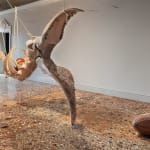Liao Wen 廖雯
I Swallow the Tide to Light Up… 我吞吐潮汐只为照亮……, 2024
Sculpture: hand-carved and painted limewood, stainless steel, natural gemstone beads, glass beads, copper threads, brass bells, leather drum, natural dye silk, nylon rope, grains, automobile grease, sea shells, 3D-printed stainless steel, vegetable-tanned cowhide and swine leather, polyurethane foam, silicone, nylon fabric
Video of live performance: single-channel color 4K video with sound
雕塑:手工雕刻和上色椴木,不锈钢,天然石珠,琉璃珠,铜丝,铜铃铛,牛皮鼓,自然染色绡,尼龙绳,谷物,机油,贝壳,3D打印不锈钢,植鞣牛皮和猪皮,聚氨酯泡沫,硅胶,尼龙布料
现场表演视频:彩色有声单频4K影像
Video of live performance: single-channel color 4K video with sound
雕塑:手工雕刻和上色椴木,不锈钢,天然石珠,琉璃珠,铜丝,铜铃铛,牛皮鼓,自然染色绡,尼龙绳,谷物,机油,贝壳,3D打印不锈钢,植鞣牛皮和猪皮,聚氨酯泡沫,硅胶,尼龙布料
现场表演视频:彩色有声单频4K影像
Sculpture 雕塑: 175 x 323 x 56 cm; 69 x 127 x 22 in
Video 视频: 11'43"
Video 视频: 11'43"
更多图片
-
(View a larger image of thumbnail 1
)

-
(View a larger image of thumbnail 2
)

-
(View a larger image of thumbnail 3
)

-
(View a larger image of thumbnail 4
)

-
(View a larger image of thumbnail 5
)

-
(View a larger image of thumbnail 6
)

-
(View a larger image of thumbnail 7
)

-
(View a larger image of thumbnail 8
)

-
(View a larger image of thumbnail 9
)

-
(View a larger image of thumbnail 10
)

-
(View a larger image of thumbnail 11
)

-
(View a larger image of thumbnail 12
)

-
(View a larger image of thumbnail 13
)

-
(View a larger image of thumbnail 14
)

-
(View a larger image of thumbnail 15
)

A gigantic whale hangs from the ceiling. Its bones are precisely numbered and its spine extends to a tail where perpendicular metal rods are inserted. Blood spills from its mouth....
A gigantic whale hangs from the ceiling. Its bones are precisely numbered and its spine extends to a tail where perpendicular metal rods are inserted. Blood spills from its mouth. During the exhibition, the scientific, specimen-like depiction of the whale will be activated – if not completed – by a brutal and vehement performance, a tale of violent human interventions in our interactions with and understandings of other species.
The story unfolds similarly to the rite of Bouphonia – ‘ox-slaying’ in Greek – a sacrificial killing performed for Zeus that resembles a combat dance. All performers are implicated in the violent act against the scapegoat (the scapewhale in this case), yet all are acquitted and guiltless before the ‘trial’.
When villagers discover a whale deep in a foggy room, some are astounded by the mysterious creature, while others wish to possess a piece of it, others are driven to mathematically analyse it with tools. As the ritual crescendos, the whale’s organs are taken out one by one, and, at some point, a villager takes the tail apart and attaches it to their own body. The whale’s fragmented body remains, like the spent wicks in whale oil lamps. Humanity’s deep-rooted obsession to absorb others into our own system of extraction is considered alongside the utilitarian exploitation of these planetary cohabitants as means for our convenience and well-being.
The story unfolds similarly to the rite of Bouphonia – ‘ox-slaying’ in Greek – a sacrificial killing performed for Zeus that resembles a combat dance. All performers are implicated in the violent act against the scapegoat (the scapewhale in this case), yet all are acquitted and guiltless before the ‘trial’.
When villagers discover a whale deep in a foggy room, some are astounded by the mysterious creature, while others wish to possess a piece of it, others are driven to mathematically analyse it with tools. As the ritual crescendos, the whale’s organs are taken out one by one, and, at some point, a villager takes the tail apart and attaches it to their own body. The whale’s fragmented body remains, like the spent wicks in whale oil lamps. Humanity’s deep-rooted obsession to absorb others into our own system of extraction is considered alongside the utilitarian exploitation of these planetary cohabitants as means for our convenience and well-being.
















